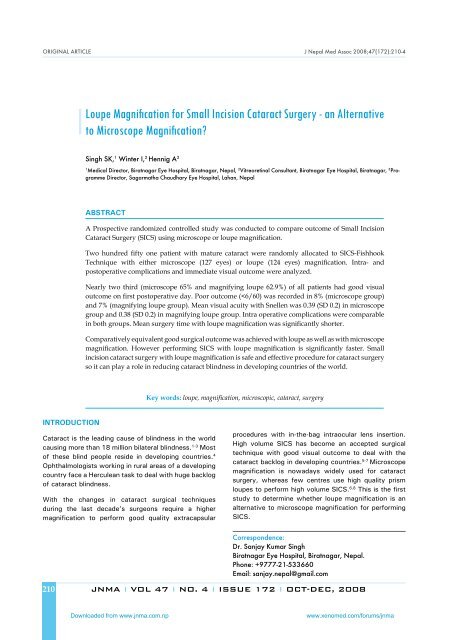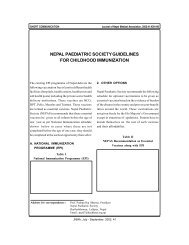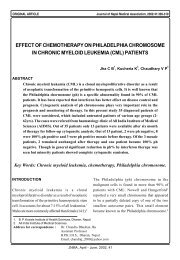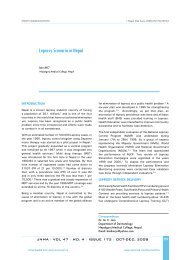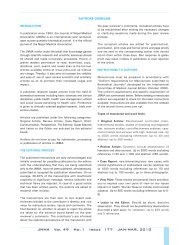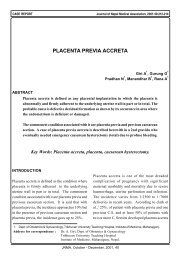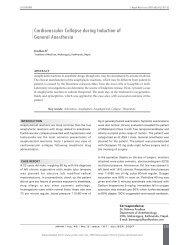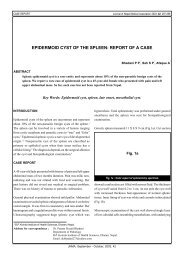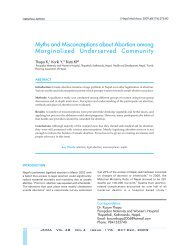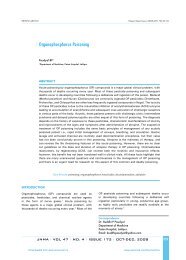Loupe Magnification for Small Incision Cataract Surgery - Journal of ...
Loupe Magnification for Small Incision Cataract Surgery - Journal of ...
Loupe Magnification for Small Incision Cataract Surgery - Journal of ...
- No tags were found...
Create successful ePaper yourself
Turn your PDF publications into a flip-book with our unique Google optimized e-Paper software.
ORIGINAL ARTICLE J Nepal Med Assoc 2008;47(172):210-4<strong>Loupe</strong> <strong>Magnification</strong> <strong>for</strong> <strong>Small</strong> <strong>Incision</strong> <strong>Cataract</strong> <strong>Surgery</strong> - an Alternativeto Microscope <strong>Magnification</strong>?Singh SK, 1 Winter I, 2 Hennig A 31Medical Director, Biratnagar Eye Hospital, Biratnagar, Nepal, 2 Vitreoretinal Consultant, Biratnagar Eye Hospital, Biratnagar, 3 ProgrammeDirector, Sagarmatha Chaudhary Eye Hospital, Lahan, NepalABSTRACTA Prospective randomized controlled study was conducted to compare outcome <strong>of</strong> <strong>Small</strong> <strong>Incision</strong><strong>Cataract</strong> <strong>Surgery</strong> (SICS) using microscope or loupe magnification.Two hundred fifty one patient with mature cataract were randomly allocated to SICS-FishhookTechnique with either microscope (127 eyes) or loupe (124 eyes) magnification. Intra- andpostoperative complications and immediate visual outcome were analyzed.Nearly two third (microscope 65% and magnifying loupe 62.9%) <strong>of</strong> all patients had good visualoutcome on first postoperative day. Poor outcome (
Singh et al. <strong>Loupe</strong> <strong>Magnification</strong> <strong>for</strong> small <strong>Incision</strong> <strong>Cataract</strong> <strong>Surgery</strong>-an Alternative to microscope magnification?MATERIAL AND METHODSA prospective hospital based randomized study wasconducted at Biratnagar Eye Hospital (BEH), Nepal, <strong>for</strong>a period <strong>of</strong> one month (13 March 2007 to 12 April2007). Verbal consent was taken from the patients.Mature senile cataracts (white or brown) were included<strong>for</strong> this study. All patients underwent slit lampexamination. Immature cataract, complicated cataract,congenital cataract, developmental cataract andcataract associated with other diseases were excludedfrom this study.Patients with mature senile cataracts were divided intotwo groups be<strong>for</strong>e receiving retrobulbar anaesthesia.Randomization was done with the help <strong>of</strong> randomnumber tables. Patients with odd numbers were selected<strong>for</strong> microscope magnification and even numbers wereselected <strong>for</strong> loupe magnification. All patients wereoperated by a single surgeon (SKS).As the operating surgeon was the only ophthalmologistavailable at BEH at the time <strong>of</strong> this study, maskingdid not seem practical. All cases were operated andexamined in the postoperative period by him. However,the visual acuity recording person was not aware <strong>of</strong> thestudy and masking could be achieved.A hand-held Auto Refract Keratometer (NIKONRetinomax K plus 2) was used <strong>for</strong> keratometry and AScan ultrasound machine (Nidek ECHO scan US 800)<strong>for</strong> the purpose <strong>of</strong> axial length measurement. Thepower <strong>of</strong> the intra ocular Lens was calculated with themodified SRK II <strong>for</strong>mula.After pupil dilatation with Tropicamide and Phenylephrineeye drops a retrobulbar injection was given in sittingposition and the patient requested to press the eye ballwith the palm <strong>of</strong> the right hand to s<strong>of</strong>ten the eyeball.Preoperative povidone iodine 10% solution was used<strong>for</strong> disinfection <strong>of</strong> the periocular skin area.The surgeon per<strong>for</strong>med the operation in either sittingposition on two tables with microscope or standingposition on three tables with a magnifying loupe. Part <strong>of</strong>the surgical steps such as <strong>for</strong>nix based conjunctival flapand cauterization <strong>of</strong> bleeding vessels were per<strong>for</strong>medby an operation theatre assistant in order to helpoptimizing the surgical time.Carl Zeiss microscope (OPMI -1 FR) or high quality CarlZeiss Prism loupe with 5 times magnification and 300mm working distance in combination with a halogenSpot light were used <strong>for</strong> the purpose <strong>of</strong> magnification.Frown shaped scleral incision, sclerocorneal tunnel,anterior chamber entry and linear capsulotomy weremade with a 3 mm diamond keratome. Hydrodissectionwas done and superior equator <strong>of</strong> the nucleus waslifted from the capsular bag. Following the injection <strong>of</strong>viscoelastics behind the lens nucleus into capsular bagthe lens nucleus could then be delivered with fish hooktechnique. With a Simcoe cannula the remaining cortexwas aspirated. PMMA posterior chamber intraocularlens was implanted and anterior chamber was filled withringer lactate solution. The operation was completedwith an intracameral injection <strong>of</strong> cefuroxime. Thesurgical time was measured from the preparation <strong>of</strong>the sclerocorneal incision to the end <strong>of</strong> the intracameralcefuroxime injection.Study variables included surgeon’s time, intraoperativeand postoperative complications and postoperativeuncorrected visual acuity on first postoperative day.Postoperative uncorrected visual acuity was taken withSnellen chart at a 6 meters distance and <strong>for</strong> the purpose<strong>of</strong> calculation was converted into decimel figure.RESULTSTwo hundred fifty one patients consented <strong>for</strong> the study,127 were operated under microscope (Group A) and124 with magnifying loupe (Group B).Baseline characteristics were similar in both groups. Ingroup A 83.5% (106 out <strong>of</strong> 127) had vision <strong>of</strong> handmovement while the remaining patients had visualacuity <strong>of</strong> 0.03. In group B 80% (99 out <strong>of</strong> 124) hadvision <strong>of</strong> hand movement and remaining had visualacuity <strong>of</strong> 0.03.Mean intraocular lens power was similar in bothgroups. Patients from group A had 22.25 D (SD 1.24)and from group B had 22.29 D (SD 1.29). Posteriorcapsule rupture with vitreous loss occurred in fourpatients from group A and one patient from group B.Inadvertent intracapsular cataract extraction occurredin one patient from group A. All patients with posteriorcapsule rupture and intracapsular cataract extractionunderwent anterior vitrectomy and had intraocular lensimplantation. In group B, one patient had prematureentry and another had wound gap and one suture wasapplied in both these patients to secure the wound.Mean time spent by the surgeon per surgery was 4minute 29 seconds in group A and 3 minute 50 secondsin group B. In group A 28.3% patients and in groupB 68.5% patients had surgery time <strong>of</strong> less than fourminutes (P value
Singh et al. <strong>Loupe</strong> <strong>Magnification</strong> <strong>for</strong> small <strong>Incision</strong> <strong>Cataract</strong> <strong>Surgery</strong>-an Alternative to microscope magnification?(2 patients), air bubble in anterior chamber (1 patients),posterior capsule opacification (1 patient) and retinitispigmentosa (1 patient) were responsible <strong>for</strong> poor visualacuity on first postoperative day in the group A. In groupB hyphaema (1 patient), corneal edema (4 patients)and age related macular degeneration (1 patient) wereresponsible <strong>for</strong> poor visual outcome. All patients butretinitis pigmentosa (1 patient) and age related maculardegeneration (1 patient) recovered with good outcomeat the time <strong>of</strong> discharge.Postoperatively uncorrected visual acuity was measuredon the first postoperative day at 7 a.m. immediatelyafter removal <strong>of</strong> the eye pad. In both groups nearly twothird (group A 65% and group B 62.9%) <strong>of</strong> patientshad good visual outcome (6/6-6/18) (P value 0.3669).Mean visual acuity was 0.39 (SD 0.2) in group A and0.38 (SD 0.2) in group B. Poor outcome (Unaided visualacuity
Singh et al. <strong>Loupe</strong> <strong>Magnification</strong> <strong>for</strong> small <strong>Incision</strong> <strong>Cataract</strong> <strong>Surgery</strong>-an Alternative to microscope magnification?excellent and reliable replacement <strong>for</strong> cataract surgerywith operating microscope on cataract blind patients inremote hilly areas and in other remote places.In past times a magnifying loupe was used to improvethe visibility and safety during intracapsular cataractextraction procedures. With the shift to extracapsularcataract extractions operating microscope was usedroutinely <strong>for</strong> the purpose <strong>of</strong> magnification. In developingcountries where largest numbers <strong>of</strong> cataract blindpatients live, ophthalmic surgeons are trained to operatewith microscope during their residency and fellowshipprograms and instinctively believe that cataractsurgeries done under microscopic magnification yielda better outcome. Findings <strong>of</strong> this study clearly showthat <strong>for</strong> small incision cataract surgeries, high qualitymagnifying loupe is as effective as the good operatingmicroscope and at the same time surgeries can beper<strong>for</strong>med faster. In a high volume surgical set up,introduction <strong>of</strong> high quality loupe magnification instead<strong>of</strong> microscope magnification will increase the numbers<strong>of</strong> cataract surgeries without increasing the number <strong>of</strong>cataract surgeons.In plains areas <strong>of</strong> Nepal all eye hospitals have increasednumber <strong>of</strong> patients in the busy periods (October toMarch). Introduction <strong>of</strong> loupe magnification will help toraise the number <strong>of</strong> cataract surgeries per<strong>for</strong>med bythese hospitals. Improved efficiency <strong>of</strong> cataract surgeonswith higher surgical output from these hospitals mayhelp in adjusting the fee structure <strong>of</strong> cataract surgeries,thus making it more af<strong>for</strong>dable to the poorer people inneed living in developing part <strong>of</strong> the world.CONCLUSION<strong>Small</strong> incision cataract surgeries were per<strong>for</strong>med fasterwith equally good visual outcome and comparativecomplication rate under high quality magnifying loupemagnification. In developing countries where cataractblindness is a major cause <strong>of</strong> avoidable blindness, smallincision cataract surgery with high quality magnifyingloupe could be an appropriate and more universal skill<strong>for</strong> the reduction <strong>of</strong> cataract blindness. A high qualitymagnifying loupe is a good alternative to the operatingmicroscope and provides similar surgical outcome withincreased output.Table 1. Baseline characteristicsMicroscope (Group A) Magnifying loupe (Group B) P valueAge (Mean +/- SD) 62.4 ( SD 11.9) yrs 62.7 ( SD 11.7) yrsMale 48% 47% 0.4364VA (HM or worse) 83.5% 80% 0.2389Mean VA (remaining patients) 0.03 (SD 0.02) 0.03 (SD 0.05)Table 2. Intraoperative findingsMicroscope (Group A) Magnifying loupe (Group B)Mean IOL power 22.25 D (SD 1.24) 22.29 D (SD 1.29)Intraoperative complications PCR + vitreous loss: 4 PCR + vitreous loss: 1ICCE: 1 Premature entry: 1Wound gap: 1Mean surgery time >4 min 71.7% 31.5% P value
Singh et al. <strong>Loupe</strong> <strong>Magnification</strong> <strong>for</strong> small <strong>Incision</strong> <strong>Cataract</strong> <strong>Surgery</strong>-an Alternative to microscope magnification?6. Hennig, A., High volume cataract surgery at Lahan EyeHospital, Nepal Management, Outcome and Cost. Asia-Pacific <strong>Journal</strong> <strong>of</strong> Ophthalmology 2003;15(4):9-11.7. Venkatesh R, et al. Outcomes <strong>of</strong> high volume cataract surgeriesin a developing country. Br J Ophthalmol 2005,89(9):1079-83.8. Hennig A, et al. Sutureless cataract surgery with nucleusextraction: outcome <strong>of</strong> a prospective study in Nepal. Br JOphthalmol 2003;87(3):266-70.9. Gogate PM, et al. Extracapsular cataract surgery comparedwith manual small incision cataract surgery in communityeye care setting in western India: a randomised controlledtrial. Br J Ophthalmol 2003;87(6):667-72.10. Ruit S, et al. A prospective randomized clinical trial <strong>of</strong>phacoemulsification vs manual sutureless small-incisionextracapsular cataract surgery in Nepal. Am J Ophthalmol2007;143(1):32-8.11. Sapkota YD, et al. Barriers to up take cataract surgery inGandaki Zone, Nepal. Kathmandu Univ Med J (KUMJ)2004;2(2):103-12.12. Ruit S, et al. Low-cost high-volume extracapsular cataractextraction with posterior chamber intraocular lensimplantation in Nepal. Ophthalmology 1999;106(10):1887-92.214JNMA I VOL 47 I NO. 4 I ISSUE 172 I OCT-DEC, 2008Downloaded from www.jnma.com.npwww.xenomed.com/<strong>for</strong>ums/jnma


